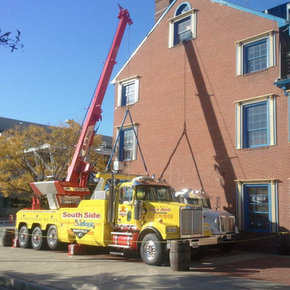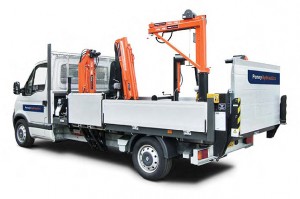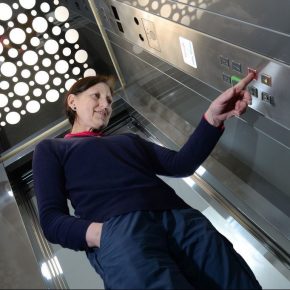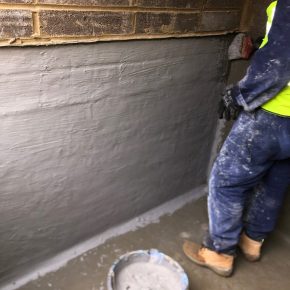
How mechanical handling equipment reduces building industry deaths
With falls posing the deadliest risk to construction professionals, we look at the role of mechanical handling equipment in avoiding preventable accidents and help to make major improvements in complying with WAHR.
High levels of on-site health and safety are always a primary concern for any construction firm. However, according to figures from the Health and Safety Executive (HSE), falls from height accounted for almost three in ten fatal injuries in workplaces in 2014/15, with almost half of those falls taking place in the construction industry. With falls posing the deadliest risk to construction professionals, it is imperative that the utmost care is taken to avoid any totally preventable accidents from occurring. One of the ways this can be done is by providing workers with access to mechanical handling equipment, training them to use it, and making sure that they do.
The HSE introduced the Work at Height Regulations (WAHR) in 2005 to combat the danger that falls pose to construction professionals. The regulations apply in any place of work where a fall could cause personal injury, which doesn’t actually need to be that high. For example, a worker loading materials from a flatbed truck could conceivably fall and cause himself injury. WAHR applies to any employer or person that controls work at a height, such as a contractor or factory owner.
The regulations endorse a sensible approach to taking the necessary precautions; there may be low-risk occasions where common sense dictates that no safety measures need to be taken. However, there are a number of considerations that need to be taken before work from a height can be planned and carried out, such as ensuring that the person carrying out the work is competent, what the weather conditions will be, and procedures for emergency or rescue. These are only a few of the steps required by the regulations — these can be read in detail in the HSE’s publication Working at Height: A Brief Guide.
In line with the regulations, where work at a height is unavoidable, falls must be prevented using either an existing place of work that is already safe or the right kind of equipment. The WAHR requires that workers use the right kind of equipment to minimise the distance and consequences of a fall, and, wherever possible, use equipment to avoid working at a height altogether. It is much safer to work from the ground, so any opportunities to use equipment to make this possible should be taken.
In situations such as these, access to manual handling equipment can make it much safer for workers to carry out potentially dangerous tasks. For example, a vehicle-mounted hydraulic crane can be used to lift objects from a height onto a truck without any workers having to scale the distance between the ground and the truck. Many models also have controls that are located at ground-level, meaning that employees don’t even have to climb the loading area either. Similarly, a hydraulic loading platform on the same vehicle could also transport the same load to the ground without workers having to climb or lift it at all.
Using equipment like this can help to eliminate many of the risks associated with working at a height. However, their usefulness will only last whilst they are properly maintained and used. The HSE also regulates the use and maintenance of manual handling equipment through their Lifting Operations & Lifting Equipment Regulations 1998 (LOLER). In line with these regulations, employers have a responsibility to service equipment and to ensure that they are regularly subjected to a Thorough Examination. In addition, they must also make sure that any staff who are going to be operating the machinery are well-trained and responsible.
 Employers can make their task easier by contacting equipment specialists, such as Penny Hydraulics, who can offer a complete end-to-end solution, including equipment, servicing, and staff training. This eliminates the need to deal with more than one firm when it comes to the upkeep and safety of machinery.
Employers can make their task easier by contacting equipment specialists, such as Penny Hydraulics, who can offer a complete end-to-end solution, including equipment, servicing, and staff training. This eliminates the need to deal with more than one firm when it comes to the upkeep and safety of machinery.
Employees themselves are also required to be to take reasonable care of themselves and others who may be affected by their actions, and to co-operate with their employer to enable their health and safety duties and requirements to be complied with.
In summary, the use of manual handling equipment can help to make major improvements in complying with WAHR and minimising the risks posed to construction workers who may be required to deal with heights in their jobs. Making sure that this machinery is properly serviced and staff are adequately trained is also a hugely important part of maintaining an excellent safety record. Investing and maintaining high-quality equipment can give employers the peace of mind that they are more than fulfilling the duty of care towards their employees.
© Photography by Michael – licence
Latest news

31st March 2025
Stannah Lifts urges lift owners to prepare for the PSTN switch over
Stannah Lifts, a leading provider of lift solutions, is calling on businesses and facility managers to act now and upgrade their lift communications systems to ensure they are ready for the UK’s new high-speed, GSM digital network.
Posted in Accessibility, Articles, Building Industry News, Building Products & Structures, Building Regulations & Accreditations, Building Services, Facility Management & Building Services, Health & Safety, Information Technology, Interiors, Lifts, Restoration & Refurbishment, Retrofit & Renovation
31st March 2025
Delta: Lift Pit Waterproofing - Type A solutions
Delta Membranes has recently worked on a project whereby the scope was to provide a waterproofing solution to a newly constructed lift pit for a four-storey residential block.
Posted in Articles, Building Industry News, Building Products & Structures, Building Services, Case Studies, Concrete, Cement, Admixtures, Damp & Waterproofing, Facility Management & Building Services, Restoration & Refurbishment, Retrofit & Renovation
31st March 2025
HMG Paints renew partnership with Belle Vue Aces Speedway
HMG Paints has renewed its partnership with Belle Vue Aces for the 2025 season. This year marks a particularly exciting chapter for Belle Vue Speedway, as the club and National Speedway Stadium will host an electrifying double-header of the FIM Speedway Grand Prix in 2025.
Posted in Articles, Building Industry News, Building Products & Structures, Case Studies, Interiors, Paints, Paints, Coatings & Finishes, Posts, Restoration & Refurbishment, Retrofit & Renovation
31st March 2025
Ideal Heating sponsored CIBSE BPA Engineer of the Year announced
As the sponsor of the Engineer of the Year award at the Chartered Institution of Building Services Engineers (CIBSE) Building Performance Awards, Ideal Heating Commercial was delighted to present the award to Volkan Doda, Head of Design Technologies at Atelier Ten.
Posted in Articles, Awards, Building Associations & Institutes, Building Industry Events, Building Industry News, Building Products & Structures, Building Services, Facility Management & Building Services, Heating Systems, Controls and Management, Heating, Ventilation and Air Conditioning - HVAC, Pipes, Pipes & Fittings, Plumbing, Retrofit & Renovation
 Sign up:
Sign up: